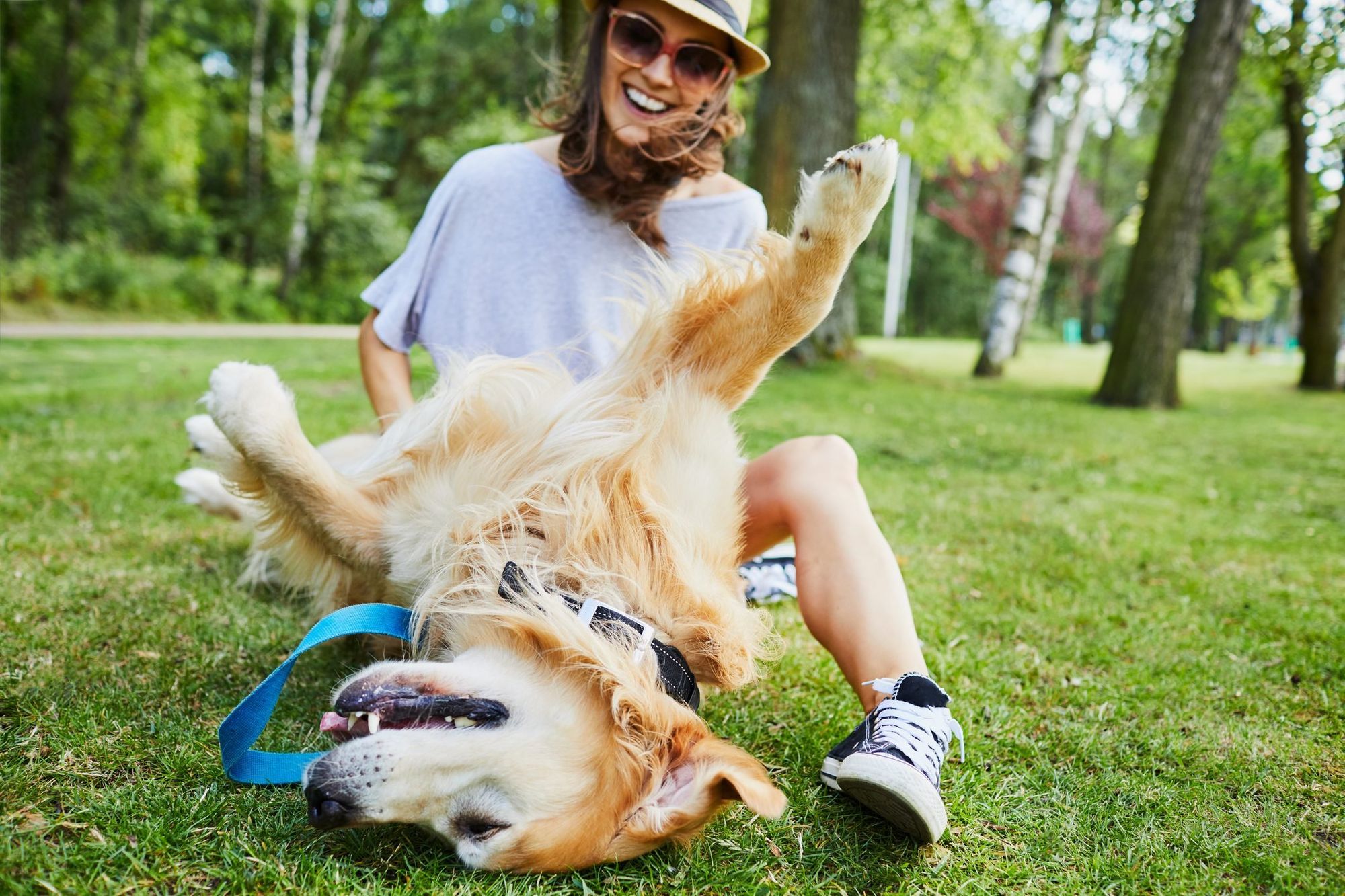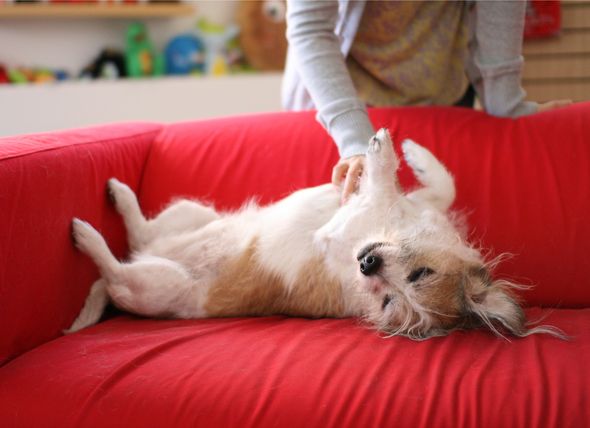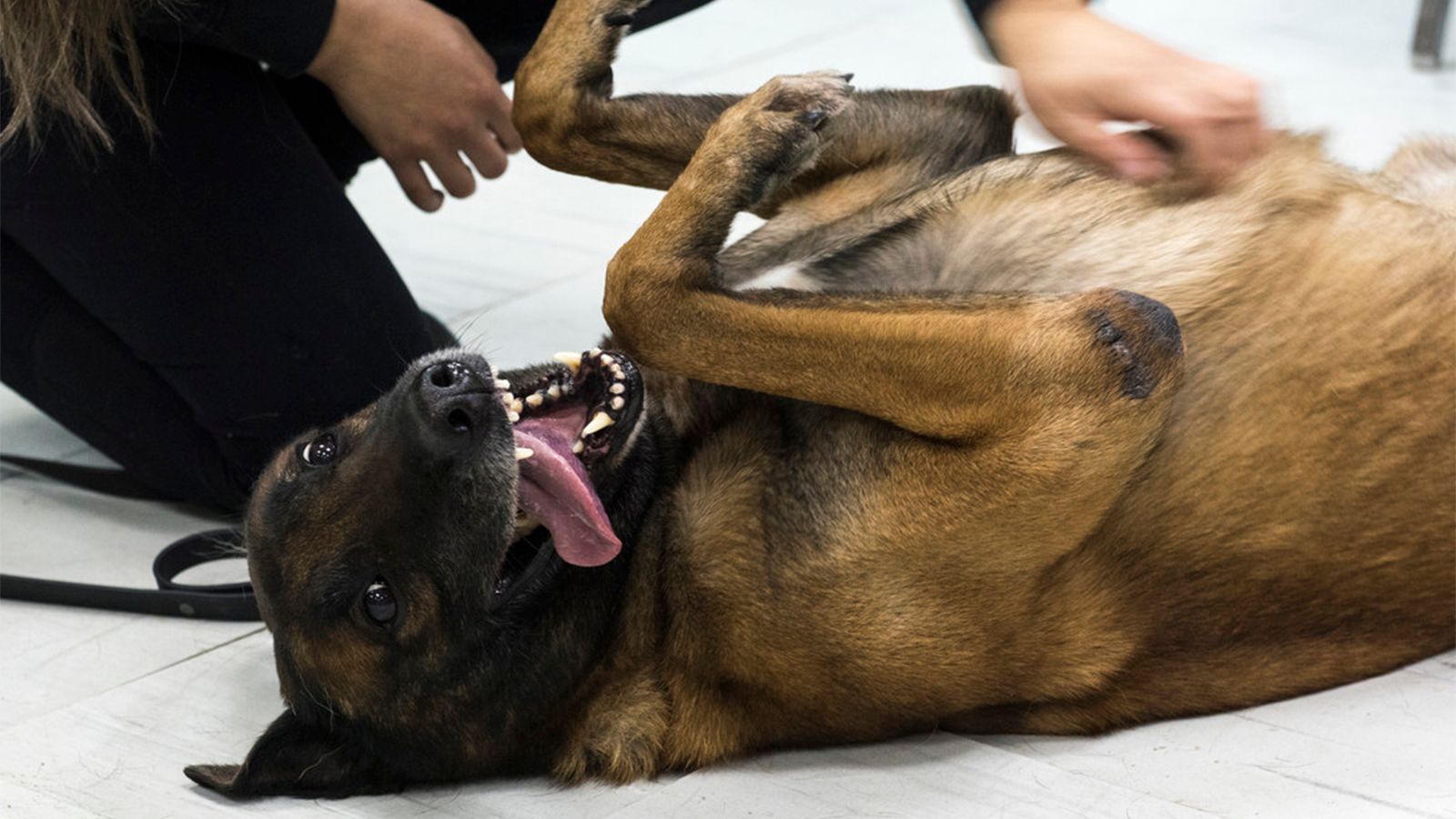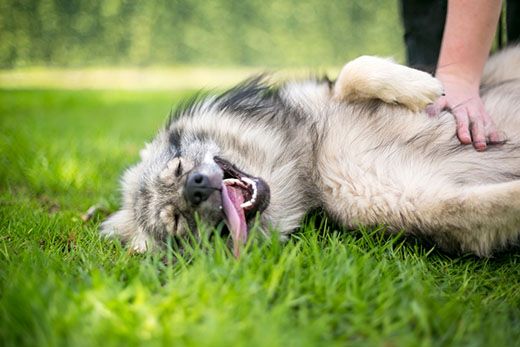Dogs are known for their love of belly rubs, but have you ever wondered why? Understanding this behavior can give us insight into the inner workings of a dog's mind and provide a deeper connection with our furry friends. Exploring the natural behavior of dogs, their enjoyment of belly rubs, and the benefits they experience can shed light on this adorable phenomenon.
Key takeaway:
- Dogs enjoy belly rubs due to sensitivity in their belly area, it feels good and comforting to them.
- Belly rubs create a sense of trust and safety for dogs, strengthening the bond between them and their human companions.
- Rubbing a dog's belly can release endorphins, leading to a sense of pleasure and relaxation for the dog.

Why Do Dogs Like Belly Rubs?
Dogs enjoy belly rubs for several reasons. So, "Why Do Dogs Like Belly Rubs?" Firstly, belly rubs provide physical pleasure and relaxation to dogs. Rubbing their bellies stimulates the release of endorphins, which are natural feel-good hormones. This brings them immense comfort and reduces stress. In addition, belly rubs can also help dogs cool down as the belly is a less insulated area on their body.
Another reason why dogs like belly rubs is because it creates a bonding experience with their owner. Dogs are social animals and cherish physical contact with their human companions. By giving them belly rubs, we are engaging in a positive interaction that strengthens the bond between us.
Furthermore, belly rubs can also be a sign of submission for dogs. When a dog exposes its belly to you, they are displaying trust and vulnerability. It is an indication that they feel safe and comfortable in your presence.
To ensure that the belly rub experience is enjoyable for both you and your dog, it is crucial to pay attention to their body language. Some dogs may not like belly rubs or have sensitive areas, so it's important to respect their boundaries. Begin with gentle strokes and observe their reaction. If they lean into it and appear relaxed, it's a good sign that they enjoy belly rubs.
Remember, each dog is unique, so it's essential to understand their preferences and respond accordingly. Building a positive and trusting relationship with your furry friend is key to ensuring they feel loved and cared for.
Why Do Dogs Enjoy Belly Rubs?
Dogs and belly rubs, a delightful combination that brings joy to both humans and canines. But have you ever wondered why dogs enjoy belly rubs so much? In this section, we'll unveil the answers, exploring the sensitivity of their bellies, the deep connection to trust and safety, and the magical release of endorphins. Get ready to dive into the fascinating world of canine belly rubs and uncover the reasons behind this adorable phenomenon.
Sensitivity of the Belly
The sensitivity of the belly is one of the reasons why dogs enjoy belly rubs so much. Here are some key factors to consider:
- Vulnerable parts: The belly is one of the most vulnerable parts of a dog's body. When they expose their belly to you, it shows a high level of trust and submission.
- Body language cues: Dogs display various body language cues when they want a belly rub, such as lying on their backs, wiggly body postures, and bright eyes. These signals indicate their desire for social contact and affection.
- Special neurons: Dogs have special neurons that respond to gentle touch and hair follicle stimulation. Belly rubs activate these neurons, providing sensory pleasure and relaxation.
- Pain relief: Belly rubs can provide pain relief for dogs. The gentle pressure and stimulation can alleviate discomfort in the abdominal area, making them feel more comfortable.
- Decrease body temperature: Dogs have fewer sweat glands, and by exposing their belly, they can cool down and regulate their body temperature more effectively.
When giving belly rubs to your dog, always be gentle and attentive to their signals. Not all dogs enjoy belly rubs, so it's important to respect their comfort levels. Pay attention to their body language and if they show any signs of discomfort, such as tense or squinty eyes, it's best to stop the belly rub. Belly rubs are a wonderful way to bond with your canine companion and provide them with a sense of relaxation and pleasure.
Connection to Trust and Safety
When dogs enjoy belly rubs, it is often connected to trust and safety. Dogs are highly sensitive animals and exposing vulnerable parts of their bodies, like their bellies, is a sign of trust and safety. By allowing their belly to be rubbed, they are showing that they feel safe and secure in their environment.
For dogs, the stomach area is considered a vulnerable position. When they expose their belly, they are displaying submissive behavior and trust in the person rubbing it. It is a way for them to communicate that they feel comfortable and close to you.
Belly rubs can trigger the release of endorphins in dogs, chemicals that foster pleasure and relaxation. This not only deepens the bond between dogs and humans but also reinforces feelings of trust and safety. It's noteworthy that, just as understanding conditions like brachycephalic syndrome and hip dysplasia is crucial for a dog's physical well-being, recognizing the emotional benefits of such interactions is equally vital for their overall sense of security and happiness.
Understanding a dog's body language cues is crucial when giving a belly rub. Look for signs of relaxation like bright eyes, a wiggly body posture, and a quiet ha ha sound. On the other hand, tense and squinty eyes or a closed mouth may indicate discomfort or anxiety, compromising the connection to trust and safety.
The connection between belly rubs and trust and safety is essential for dogs. It is a demonstration of their comfort and trust in their human companions. So the next time your dog rolls on their back and exposes their belly, take it as a sign of their connection to trust and safety and their love for you.
Release of Endorphins
The release of endorphins is one of the main reasons why dogs find belly rubs so enjoyable. Endorphins are natural chemicals present in a dog's body that serve as both pain relievers and mood enhancers. When a dog receives a belly rub, it triggers the release of endorphins, leading to a pleasurable sensation and a feeling of relaxation in the dog.
Not only do these endorphins provide instant pleasure, but they also offer long-term benefits for the well-being of dogs. They can help alleviate stress and anxiety, provide natural relief from pain, and improve overall mood. Moreover, the release of endorphins during a belly rub can contribute to the development of trust and the strengthening of the bond between dogs and their owners or caregivers.

It is crucial to closely observe your dog's body language cues while giving them a belly rub to ensure they are truly enjoying the experience. Look for signs of relaxation, such as bright eyes, a wiggly body posture, and a display of contentment. Conversely, squinty or tense eyes, low body postures, or indications of discomfort may indicate that the dog is not enjoying the belly rub.
Pro-tip: When starting a belly rub session with your dog, begin with gentle strokes and carefully monitor their reaction. If they exhibit signs of enjoyment, you can continue. Remember, every dog is unique, so it is vital to respect their comfort level and immediately stop the interaction if they display any signs of discomfort or express a desire to end the belly rub.
How Dogs Express Pleasure during Belly Rubs
When it comes to belly rubs, dogs have a unique way of expressing pleasure. In this section, we'll explore how dogs communicate their joy during these delightful moments. From their body language and posture to vocalizations and sighs, we'll uncover the fascinating ways dogs let us know just how much they enjoy those belly rubs. So, let's dive in and decode the secrets behind our furry friends' expressions of pure bliss!
Body Language and Posture
Dogs communicate a lot through their body language and posture, and this is also true when it comes to expressing their love for belly rubs. When dogs enjoy a belly rub, their body language is often relaxed and joyful. They may wag their tails, have bright eyes, and display a wiggly body posture, all of which are signs of their enjoyment.
In addition, some dogs may even roll onto their backs, exposing their vulnerable belly, which demonstrates trust and submission in their body language. Their eyes may become squinty and tense, showing pure delight. Furthermore, dogs may open their mouths slightly and make a quiet ha ha sound to express pleasure. Their body posture is low, indicating submission and relaxation. They may also lean into your touch and stay close to you, seeking that social contact to further signify their contentment.
From a physiological standpoint, belly rubs can actually bring physical benefits to dogs. Petting and belly rubs can release endorphins, which serve as natural pain relievers and mood boosters. Moreover, they can help decrease a dog's body temperature, providing relief for anxious canines. Additionally, belly rubs stimulate the hair follicles and activate special neurons that create a pleasurable sensation for the dog.

Vocalization and Sighs
Dogs frequently express their enjoyment and relaxation through vocalization and sighing while receiving belly rubs. This vocalization and sighing serve as clear indications of their pleasure. When dogs are content and happy, they might emit a soft sigh or produce a low, rumbling sound similar to a purr. These vocalizations may vary from one dog to another, but they all signify pleasure.
While being pampered with belly rubs, dogs may also vocalize in other ways, such as whining or grunting, which further displays their satisfaction. These sounds are often accompanied by a relaxed body posture, alert eyes, and lively body movements. Dogs may even extend their bodies and roll onto their backs to demonstrate their eagerness for more belly rubs.
These vocalizations are a means for dogs to communicate their enjoyment and gratitude. It's their way of saying, "I adore this, please continue!" Dogs may also employ vocalizations to strengthen their bond with their human companions since they associate belly rubs with positive social contact and affection.
Alongside vocalizations, dogs may exhibit additional body language cues that indicate their delight in belly rubs. These cues can include a relaxed mouth, squinty and alert eyes, and a lowered body posture. Some dogs may even emit a subtle ha ha sound, further demonstrating their joy and relaxation.
Vocalization and sighs during belly rubs are how dogs express their pleasure and enjoyment. These sounds, combined with other bodily signals, clearly reveal that dogs love and value this form of interaction with their human companions. Interestingly, seasonal shedding can often lead to more frequent belly rub sessions as pet owners try to soothe their pets. Likewise, after a long walk, many dogs might roll over, seeking the comfort of a belly rub to relax and bond.
Some Facts About Why Dogs Like Belly Rubs:
✅ Dogs love belly rubs because it is a form of social contact and the fur on their belly is usually less dense and softer, making the sensation more enjoyable.
✅ Some dogs prefer touch over other types of rewards, such as treats or toys.
✅ Not all dogs like belly rubs, especially more dominant breeds or guard dogs, who may view it as aggression.
✅ Dogs roll onto their backs for various reasons, including to cool off in hot weather, invite play with puppies or human toddlers, or as a signal of submission when they are afraid or threatened.
✅ To know if your dog is inviting a belly rub, look at their body language. A friendly and sociable signal includes a dog rolling onto its back with an open mouth, tongue out, and wide-open eyes.
Frequently Asked Questions
Why do dogs like belly rubs?
Dogs like belly rubs because it is a form of social contact and the fur on their belly is usually less dense and softer, making the sensation more enjoyable. Some dogs prefer touch over other types of rewards, such as treats or toys.
What are the signs that a dog wants a belly rub?
When a dog wants a belly rub, they may roll onto their back with an open mouth, tongue out, and wide-open eyes. This friendly and sociable body language shows that they are inviting a belly rub.
Why do dogs roll on their backs?
Dogs roll on their backs for various reasons. It can be a way to cool off in hot weather or to invite play with puppies or human toddlers. Additionally, rolling onto their back can be a submissive behavior when they are afraid or threatened.

What is the best way to give a belly rub to a dog?
When giving a belly rub, it's important to keep your hands away from your dog's head and lightly scratch the upper region of their chest. Pay attention to their reaction - if they seem relaxed and comfortable, you can continue. However, if they stiffen or seem anxious, it's best to stop.
Do all dogs like belly rubs?
No, not all dogs like belly rubs. Some more dominant breeds or guard dogs may view it as aggression. It's important to respect your dog's personal preference and not force belly rubs if they are uncomfortable with it.
What are the benefits of giving a dog a belly rub?
Giving a dog a belly rub can help with bonding and affection. Dogs enjoy the soothing and relaxing sensation, and it can strengthen the bond between the dog and their owner. Additionally, allowing someone to rub their belly is a sign that a dog feels safe and trusts that person.
Conclusion:
In conclusion, the affection dogs show for belly rubs is deeply rooted in their biology, behavior, and the bond they share with humans. These gentle gestures are not just a trivial act of pampering but signify trust, contentment, and social connection. As we unravel the mystery, it's clear that belly rubs are more than just a playful interaction; they are a testament to the deep-seated relationship between dogs and their caregivers. So, the next time your furry friend rolls over, remember the layers of meaning behind that simple gesture and cherish the bond it represents.

